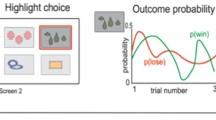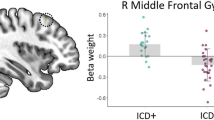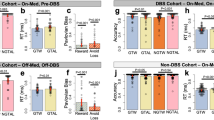Abstract
Parkinson’s disease (PD) patients with impulse control disorders (ICD) frequently report hypersensitivity to rewards. However, a few studies have explored the effectiveness of modulation techniques on symptoms experienced by these patients. In this study, we assessed the effect of anodal tDCS over the DLPFC on reward responsiveness and valuation in PD patients with ICD. 43 participants (15 PD patients with ICD, 13 PD without ICD, and 15 healthy matched controls) were asked to perform a reward-craving test employing both explicit (self-ratings of liking and wanting) and implicit (heart rate and skin conductance response) measures, as well as two temporal discounting tasks with food and money rewards. Each participant performed the experimental tasks during active anodal tDCS of the left dorsolateral prefrontal cortex (DLPFC), anodal tDCS of the primary motor cortex (M1), and sham tDCS. Results showed increased wanting and a steeper temporal discounting of rewards in PD with ICD compared to the other groups. Moreover, we found that PD without ICD exhibit reduced liking for rewards. tDCS results capable to modulate the altered intensity of PD patients’ liking, but not wanting and temporal discounting of rewards in PD patients with ICD. These findings confirm that alterations in reward responsiveness and valuation are characteristics of impulse control disorders in patients with PD but suggest that anodal tDCS over the left DLPFC is not capable to influence these processes. At the same time, they provide new insight into affective experience of rewards in PD.



Similar content being viewed by others
References
O’Sullivan SS, Wu K, Politis M et al (2011) Cue-induced striatal dopamine release in Parkinson’s disease-associated impulsive-compulsive behaviours. Brain 134:969–978. https://doi.org/10.1093/brain/awr003
Politis M, Loane C, Wu K et al (2013) Neural response to visual sexual cues in dopamine treatment-linked hypersexuality in Parkinson’s disease. Brain 136:400–411. https://doi.org/10.1093/brain/aws326
Olney JJ, Warlow SM, Naffziger EE, Berridge KC (2018) Current perspectives on incentive salience and applications to clinical disorders. Curr Opin Behav Sci 22:59–69
Kable JW (2014) Valuation, intertemporal choice, and self-control. Neuroeconomics, pp 173–192
Terenzi D, Mainetto E, Barbato M et al (2019) Temporal and effort cost decision-making in healthy individuals with subclinical psychotic symptoms. Sci Rep 9:1–9. https://doi.org/10.1038/s41598-018-38284-x
Paz-Alonso PM, Navalpotro-Gomez I, Boddy P et al (2020) Functional inhibitory control dynamics in impulse control disorders in Parkinson’s disease. Mov Disord 35:316–325
Voon V, Reynolds B, Brezing C et al (2010) Impulsive choice and response in dopamine agonist-related impulse control behaviors. Psychopharmacology 207:645–659. https://doi.org/10.1007/s00213-009-1697-y
Housden CR, O’Sullivan SS, Joyce EM et al (2010) Intact reward learning but elevated delay discounting in Parkinson’s disease patients with impulsive-compulsive spectrum behaviors. Neuropsychopharmacology 35:2155–2164. https://doi.org/10.1038/npp.2010.84
Spielberg JM, Stewart JL, Levin RL et al (2008) Prefrontal cortex, emotion, and approach/withdrawal motivation. Soc Personal Psychol Compass 2:135–153. https://doi.org/10.1111/j.1751-9004.2007.00064.x
Staudinger MR, Erk S, Walter H (2011) Dorsolateral prefrontal cortex modulates striatal reward encoding during reappraisal of reward anticipation. Cereb Cortex. https://doi.org/10.1093/cercor/bhr041
Sellitto M, Ciaramelli E, di Pellegrino G (2010) Myopic discounting of future rewards after medial orbitofrontal damage in humans. J Neurosci 30:16429–16436. https://doi.org/10.1523/JNEUROSCI.2516-10.2010
Trojak B, Soudry-Faure A, Abello N et al (2016) Efficacy of transcranial direct current stimulation (tDCS) in reducing consumption in patients with alcohol use disorders: study protocol for a randomized controlled trial. Trials 17:250. https://doi.org/10.1186/s13063-016-1363-8
He Q, Chen M, Chen C et al (2016) Anodal stimulation of the left DLPFC increases IGT scores and decreases delay discounting rate in healthy males. Front Psychol. https://doi.org/10.3389/fpsyg.2016.01421
Terenzi D, Rumiati RI, Catalan M et al (2018) Reward sensitivity in Parkinson’s patients with binge eating. Park Relat Disord 51:79–84
Kuoppa P, Pulkkinen K, Tarvainen MP et al (2016) Psychophysiological responses to positive and negative food and nonfood visual stimuli. J Neurosci Psychol Econ 9:78. https://doi.org/10.1037/npe0000053
Cecchetto C, Rumiati RI, Aiello M (2017) Alexithymia and emotional reactions to odors. Sci Rep 7:1–12. https://doi.org/10.1038/s41598-017-14404-x
Boggio PS, Ferrucci R, Rigonatti SP et al (2006) Effects of transcranial direct current stimulation on working memory in patients with Parkinson’s disease. J Neurol Sci 249:31–38. https://doi.org/10.1016/j.jns.2006.05.062
Valentino F, Cosentino G, Brighina F et al (2014) Transcranial direct current stimulation for treatment of freezing of gait: a cross-over study. Mov Disord. https://doi.org/10.1002/mds.25897
Da Silva DCL, Lemos T, De Sá FA et al (2018) Effects of acute transcranial direct current stimulation on gait kinematics of individuals with parkinson disease. Top Geriatr Rehabil. https://doi.org/10.1097/TGR.0000000000000203
Manenti R, Brambilla M, Rosini S et al (2014) Time up and go task performance improves after transcranial direct current stimulation in patient affected by Parkinson’s disease. Neurosci Lett. https://doi.org/10.1016/j.neulet.2014.07.052
Fertonani A, Ferrari C, Miniussi C (2015) What do you feel if I apply transcranial electric stimulation? Safety, sensations and secondary induced effects. Clin Neurophysiol 126:2181–2188. https://doi.org/10.1016/j.clinph.2015.03.015
Weintraub D, Mamikonyan E, Papay K et al (2012) Questionnaire for impulsive-compulsive disorders in Parkinson’s disease-rating scale. Mov Disord 27:242–247. https://doi.org/10.1002/mds.24023
Tomlinson CL, Stowe R, Patel S et al (2010) Systematic review of levodopa dose equivalency reporting in Parkinson’s disease. Mov Disord 25:2649–2653. https://doi.org/10.1002/mds.23429
Mengotti P, Aiello M, Terenzi D et al (2018) How brain response and eating habits modulate food energy estimation. Physiol Behav. https://doi.org/10.1016/j.physbeh.2018.01.015
Petschow C, Scheef L, Paus S et al (2016) Central pain processing in early-stage Parkinson’s disease: a laser Pain fMRI study. PLoS ONE 11:e0164607. https://doi.org/10.1371/journal.pone.0164607
Measso G, Cavarzeran F, Zappalà G et al (1993) The mini-mental state examination: normative study of an Italian random sample. Dev Neuropsychol 9:77–85. https://doi.org/10.1080/87565649109540545
Orsini A, Grossi D, Capitani E et al (1987) Verbal and spatial immediate memory span: normative data from 1355 adults and 1112 children. Ital J Neurol Sci 8:537–548. https://doi.org/10.1007/BF02333660
Spinnler H, Tognoni G (1987) Gruppo italiano per lo studio neuropsicologico dell’invecchiamento. Standardizzazione e taratura italiana di Test Neuropsicologici. Ital J Neurol Sci 12:461–466. https://doi.org/10.1136/emj.2008.070474
Shamosh NA, Gray JR (2008) Delay discounting and intelligence: a meta-analysis. Intelligence 36:289–305
Costantini M, Musso M, Viterbori P et al (1999) Detecting psychological distress in cancer patients: validity of the Italian version of the hospital anxiety and depression scale. Support Care Cancer 7:121–127. https://doi.org/10.1007/s005209900026
Kapur S, Mizrahi R, Li M (2005) From dopamine to salience to psychosis-linking biology, pharmacology and phenomenology of psychosis. Schizophr Res 79(1):59–68
Sienkiewicz-Jarosz H, Scinska A, Swiecicki L et al (2013) Sweet liking in patients with Parkinson’s disease. J Neurol Sci 329:17–22. https://doi.org/10.1016/j.jns.2013.03.005
Loas G, Duru C, Godefroy O, Krystkowiak P (2014) Hedonic deficits in Parkinson’s disease: is consummatory anhedonia specific? Front Neurol. https://doi.org/10.3389/fneur.2014.00024
Spalletta G, Fagioli S, Meco G et al (2013) Hedonic tone and its mood and cognitive correlates in Parkinson’s disease. Depress Anxiety 30:85–91. https://doi.org/10.1002/da.22036
Pettorruso M, Spagnolo PA, Leggio L et al (2018) Repetitive transcranial magnetic stimulation of the left dorsolateral prefrontal cortex may improve symptoms of anhedonia in individuals with cocaine use disorder: a pilot study. Brain Stimul 11(5):1195–1197
Song S, Zilverstand A, Gui W et al (2019) Effects of single-session versus multi-session non-invasive brain stimulation on craving and consumption in individuals with drug addiction, eating disorders or obesity: a meta-analysis. Brain Stimul 12(3):606–618
Kekic M, McClelland J, Campbell I et al (2014) The effects of prefrontal cortex transcranial direct current stimulation (tDCS) on food craving and temporal discounting in women with frequent food cravings. Appetite. https://doi.org/10.1016/j.appet.2014.03.010
Castrellon JJ, Meade J, Greenwald L et al (2021) Dopaminergic modulation of reward discounting in healthy rats: a systematic review and meta-analysis. Psychopharmacology. https://doi.org/10.1007/s00213-020-05723-5
Girard R, Obeso I, Thobois S et al (2019) Wait and you shall see: sexual delay discounting in hypersexual Parkinson’s disease. Brain. https://doi.org/10.1093/brain/awy298
Simioni AC, Dagher A, Fellows LK (2012) Dissecting the effects of disease and treatment on impulsivity in Parkinson’s disease. J Internat Neuropsychol Soc 18(6):942–951
Minarik T, Berger B, Althaus L et al (2016) The importance of sample size for reproducibility of tDCS effects. Front Hum Neurosci. https://doi.org/10.3389/fnhum.2016.00453
Foroni F, Pergola G, Argiris G, Rumiati RI (2013) The FoodCast research image database (FRIDa). Front Hum Neurosci 7:51. https://doi.org/10.3389/fnhum.2013.00051
Acknowledgements
We thank the participants for the time they gave to participate in this study.
Funding
This research did not receive any specific grant from funding agencies in the public, commercial, or not-for-profit sectors.
Author information
Authors and Affiliations
Contributions
DT: conceptualization, methodology, investigation, data curation, formal analysis, and writing original draft; MC: organization of research project, review and critique; PP: organization of research project; CB: organization of research project; PM: review and critique; RIR: review and critique; MA: conceptualization, methodology, formal analysis, writing original draft, review and critique. All the authors have approved the final article.
Corresponding author
Ethics declarations
Conflicts of interest
The authors declare no conflict of interest.
Ethics approval
The study was approved by SISSA Ethics Committee. The study was performed in line with the principles of the 1964 Helsinki Declaration.
Consent to participate
All the participants gave written informed consent to participate in the study.
Supplementary Information
Below is the link to the electronic supplementary material.
Rights and permissions
About this article
Cite this article
Terenzi, D., Catalan, M., Polverino, P. et al. Effects of tDCS on reward responsiveness and valuation in Parkinson’s patients with impulse control disorders. J Neurol 269, 1557–1565 (2022). https://doi.org/10.1007/s00415-021-10733-0
Received:
Revised:
Accepted:
Published:
Issue Date:
DOI: https://doi.org/10.1007/s00415-021-10733-0




